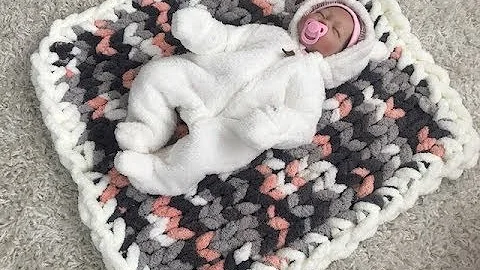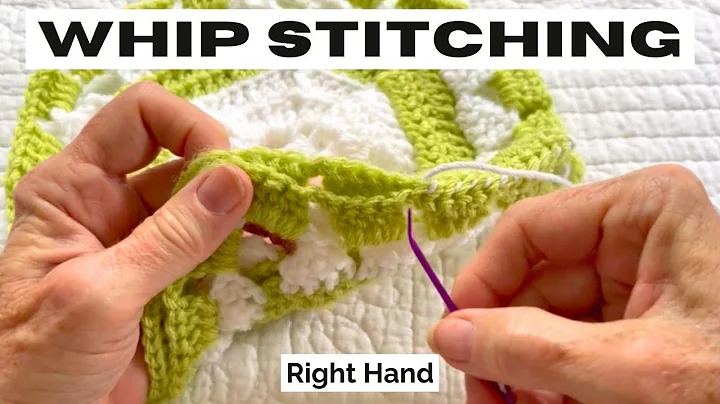Master the C2C Graphs: Double Crochet Gauge
Table of Contents
- Introduction
- Understanding Gauge
- 2.1 The Importance of Gauge
- 2.2 Comparing Corner to Corner Crochet and Double Crochet
- 2.3 Gauge Issues and How to Fix Them
- Working with Sample Swatches
- 3.1 The Role of Sample Swatches in Determining Gauge
- 3.2 Choosing the Right Hook Size
- 3.3 Blocking and Stretching Sample Swatches
- Gauge Tips for Different Projects
- 4.1 Gauge Considerations for Wall Hangings
- 4.2 Gauge Considerations for Pillow Covers
- 4.3 Gauge Considerations for Blankets
- 4.4 Gauge Considerations for Bags
- Conclusion
Understanding Gauge in Crochet: Why It Matters and How to Get It Right
Crochet projects come in all shapes and sizes, from wall hangings to blankets and bags. One crucial factor that determines the final outcome of your project is gauge. In this article, we will delve into the world of gauge in crochet, specifically focusing on the differences between corner to corner crochet and double crochet. We will explore the importance of gauge, how to compare the two crochet techniques, and address common gauge issues and how to fix them.
2. Understanding Gauge
Gauge refers to the number of stitches and rows per inch that you achieve when crocheting with a specific hook and yarn combination. While it may seem like an optional step, especially for smaller projects, gauge is essential for ensuring that your project turns out the right size. Failure to achieve the correct gauge can result in a project that is either too small or too large, ruining all your hard work.
2.1 The Importance of Gauge
If you're wondering why gauge matters, consider the following scenario: you're working on a wall hanging pattern, and you want all your pieces to be the same size. To achieve this consistency, you need to make sure your gauge is accurate. Even small variations in gauge can lead to significant differences in the final size of your project.
2.2 Comparing Corner to Corner Crochet and Double Crochet
In corner to corner crochet, the standard practice is to work three double crochet stitches to create a square. However, these stitches are worked around the turning chain and not into the stitches of the previous row. This method exposes the top of the stitch, making the double crochet larger. As a result, three double crochet stitches are needed to match the width of a complete double crochet.
On the other hand, in traditional double crochet, you work into the top of the previous row's stitch, which hides the top strand of yarn, making the double crochet appear shorter. As a result, only two double crochet stitches are needed to match the width of a complete double crochet.
2.3 Gauge Issues and How to Fix Them
When comparing a corner to corner crochet swatch to a double crochet swatch, discrepancies in gauge can arise. These differences in gauge can be attributed to the technique's construction, leading to variations in stitch size. Luckily, there are ways to fix gauge issues.
One approach is to experiment with different hook sizes. By using a larger or smaller hook, you can adjust the size of your stitches to achieve the desired gauge. However, it's crucial to ensure that your resulting sample swatch is still square, as any distortions can impact the final look of your project.
3. Working with Sample Swatches
To determine gauge accurately, sample swatches play a crucial role. These swatches allow you to test different hook sizes and yarn combinations, ensuring your project's measurements align with the pattern. Here's how to make the most of your sample swatches.
3.1 The Role of Sample Swatches in Determining Gauge
A sample swatch is a small section of fabric that you crochet using your chosen stitch pattern, hook, and yarn. It provides a preview of how your project will turn out in terms of size and texture. When making a sample swatch, aim for a size that accurately represents the stitches per inch mentioned in the pattern.
3.2 Choosing the Right Hook Size
Selecting the appropriate hook size is key to achieving the correct gauge. If your swatch is smaller than the required size, it means you need to use a larger hook size to create bigger stitches. Conversely, if your swatch is larger than the required size, you should opt for a smaller hook size to create smaller stitches. The goal is to match the pattern's recommended gauge and create a swatch that is equal in width and height.
3.3 Blocking and Stretching Sample Swatches
After crocheting your sample swatch, you may find that the dimensions are slightly off. This is where blocking comes in. Blocking involves wetting your swatch and then shaping and drying it to adjust its dimensions. Additionally, stretching the swatch can also help achieve the desired size. However, it's important to note that blocking and stretching should only be done if the pattern allows for it. Always double-check the instructions and recommendations before proceeding.
4. Gauge Tips for Different Projects
Different crochet projects have unique considerations when it comes to gauge. Here are some tips to keep in mind for various types of projects.
4.1 Gauge Considerations for Wall Hangings
For wall hanging projects, achieving consistent gauge is vital, especially if you want all the pieces to be the same size. Pay attention to the recommended gauge and adjust your hook size accordingly to match it accurately. Blocking can be particularly useful for wall hangings, as it helps even out any discrepancies in size.
4.2 Gauge Considerations for Pillow Covers
When making crochet pillow covers, gauge is essential to ensure the cover fits over the pillow snugly. Be sure to follow the pattern's recommended gauge and adjust your hook size if needed. Keep in mind that certain stitch patterns may be more forgiving in terms of gauge, allowing for slight variations without affecting the overall fit.
4.3 Gauge Considerations for Blankets
Gauge becomes especially crucial for blanket projects, as size variations can significantly impact the final dimensions. Check the pattern's gauge and work on a sample swatch to ensure you're using the correct hook size. Blocking can help align the stitches and create a uniform look across the entire blanket.
4.4 Gauge Considerations for Bags
When crocheting bags, gauge directly affects the size and functionality of the final product. Pay close attention to the pattern's recommended gauge, as variations can result in bags that are too small or too large. Blocking and stretching may be necessary to achieve the desired size and shape.
5. Conclusion
Gauge plays a crucial role in crochet projects, determining the final size and appearance of your work. By understanding the differences between corner to corner crochet and double crochet, you can make informed decisions about hook sizes and achieve accurate gauge. Remember to work with sample swatches, adjusting hook sizes and using blocking techniques if needed. Whether you're making wall hangings, pillow covers, blankets, or bags, achieving the correct gauge will help ensure beautiful and well-fitting crochet creations.
Highlights
- Gauge is essential in crochet projects to ensure the correct size and appearance.
- Corner to corner crochet and double crochet have different stitch constructions, leading to variations in gauge.
- Sample swatches are crucial in determining gauge and allow for adjustments with hook sizes and blocking.
- Wall hangings, pillow covers, blankets, and bags each have specific gauge considerations.
- Achieving accurate gauge produces well-fitting and visually pleasing crochet projects.
Frequently Asked Questions (FAQ)
Q: Why is gauge important in crochet projects?
A: Gauge ensures that your crochet project turns out the correct size and fits the desired dimensions.
Q: How do I determine the correct gauge for my crochet project?
A: You can determine the correct gauge by working a sample swatch using the recommended hook size and yarn mentioned in the pattern. Compare the stitch and row count to the pattern's measurements to check if they match.
Q: What should I do if my gauge doesn't match the pattern's recommendation?
A: If your gauge doesn't match the pattern's recommendation, you can adjust it by using a different hook size. A larger hook will create larger stitches, while a smaller hook will create smaller stitches. Remember to keep the swatch square and consider blocking if necessary.
Q: Can I skip working a sample swatch for smaller crochet projects?
A: While working a sample swatch may seem unnecessary for smaller projects, it is still recommended to ensure consistency and accuracy in size. Small variations in gauge can lead to noticeable differences in the final result.
Q: What are some common gauge issues and how can I fix them?
A: Common gauge issues include the swatch being too small or too large. To fix these issues, you can adjust the hook size accordingly. If the swatch is too small, try using a larger hook, and if it's too large, switch to a smaller hook. Blocking and stretching the swatch can also help in achieving the desired size and shape.
 WHY YOU SHOULD CHOOSE BEAUTYBADY
WHY YOU SHOULD CHOOSE BEAUTYBADY







